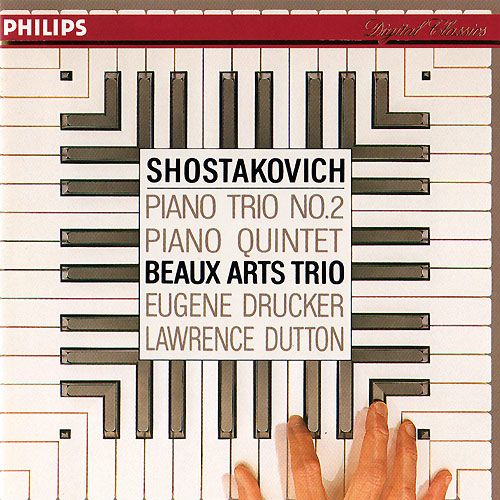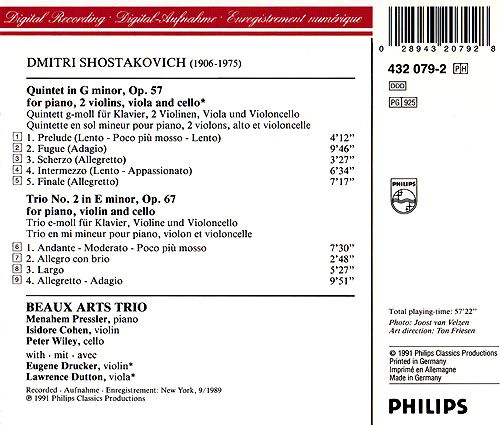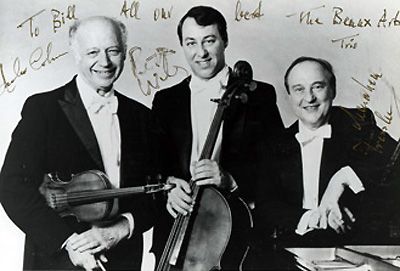wimpel69
11-26-2014, 01:00 PM
EAC-FLAC link below. This is my own rip. Complete artwork,
LOG and CUE files included. Do not share. Buy the original!
Please leave a "Like" or "Thank you" if you enjoyed this!
The Quintet for piano and strings in G minor, Op. 57, by Dmitri Shostakovich, was composed in
1940. The work was written in response to an enthusiastic request from the members of the Beethoven String
Quartet, one of the former Soviet bloc's most respected chamber ensembles of the period. The group had
recently programmed Shostakovich's first string quartet, and had been so impressed by the piece that the
players decided unanimously to seek a new piece from the composer, which would also involve a pianist.
The new work took shape quickly, and Shostakovich completed it on September 14, 1940. Again at the
request of the four quartet members, he took the difficult piano part himself at the first performance, given
in November 1940 at the Moscow Conservatory. It proved an immediate popular and critical success, and
many commentators agreed that the quintet was among Shostakovich's finest creations up until that point.
Even the normally frosty Moscow newspapers were unstinting in their praises, with the Literaturnaya Gazeta
describing the work in glowing terms as "a portrait of our age...the rich-toned, perfect voice of the present."
During 1941, Shostakovich's Piano Quintet received the inaugural Stalin Prize. In addition to the honor and
artistic prestige that accompanied the award, the composer also received the coveted cash prize of 100,000
rubles, all of which Shostakovich handed over immediately for the benefit of impoverished Muscovites.
The quintet is made (somewhat unusually for this chamber genre) of five movements, each of which is in
readily accessible populist style, and characterized by clearly etched and powerful melodies. The most
substantial section, a fugue, follows a prelude in which the generally public mood of the work begins to be
established. After the fugal second movement, there follows a brief, pithy scherzo, and an intermezzo which
takes the place of the conventional slow movement, before the work ends with a brilliant finale. Virtuoso
scoring and a particularly testing and soloistic piano part continue to make the piano quintet Shostakovich's
most frequently played chamber work, perhaps overtaken in popularity only by his String Quartet No. 8.
Shostakovich's Piano Trio No.2, Op. 67, is remarkable for a number of reasons. It was written in 1944,
just after his Symphony No. 8, with which it shares its overall structure; it is a lamentation for both
Shostakovich's close friend, musicologist Ivan Sollertinsky, and the victims of the Holocaust, the news of
which horror did not reach the U.S.S.R. until the liberation of the camps began; and it is his first work to
employ a "Jewish theme," a musical tribute that used the scales and rhythms of Jewish folk music as
Shostakovich knew it. Shostakovich began composing the trio in December 1943. He had only completed
sketches, which he was able to share with Sollertinsky before Sollertinsky's death in February 1944.
Shostakovich performed the piano part in the premiere, on November 14, 1944, in Leningrad, with
violinist Dmitri Tsyganov and cellist Sergei Shirinsky, both members of the Beethoven String Quartet.
The first movement begins with an Andante canon, the melody played first by the cello in harmonics,
which makes it the top voice, then the violin, which becomes the lower string voice, followed by the
piano in the lowest register. This then breaks into a slightly faster Moderato, where the same melody
is developed into a second one, and the use of canon continues. This movement is followed by a
scherzo, but one with bitter humor in the key of F sharp major. It is a fast, waltz-like whirl of a
movement. The B flat minor Largo third movement opens with large block chords from the piano.
This chorale theme becomes the ostinato bass of a passacaglia, repeated a total of six times, while
the violin and cello are again in canon with a sombre, lamenting melody full of anguished, minor
second dissonances between the two parts. This moves immediately into the final Allegretto, again
in E minor. Here the Jewish figurations -- the Dorian mode with an augmented fourth and the iambic
rhythms -- are used in a macabre dance that is contrasted against a stern march and five-beat climbs
up and down the scale. The strings frequently play pizzicato to add to the sharpness of the dance.
The movement ends as the dance gives way to the chorale of the Largo, but this time ending in
the more comforting key of E major.

Music Composed by
Dmitri Shostakovich
Played by the
Beaux Arts Trio
With
Eugene Drucker (violin)
Lawrence Dobkin (viola)

"The Borodin Trio (Rostislav Dubinsky, violin, Luba Edlina, piano, and Yuli Turovsky, cello) join
forces with guest Mimi Zweig, violin, and Jerry Horner, viola in performing the demanding but
intoxicatingly beautiful Piano Quintet in G minor, Opus 57 and as a trio the Piano Trio in E minor,
Opus 67. Both works are from the 1940s (Quintet 1940, Trio 1944), the war years in Europe
and the world. Yet despite the references to angst in the works they both abound in some light
passages that could very well be tongue in cheek, being works form a composer who never
quite aligned with his native country's choices of governance.
The Quintet opens with a spacious, plangent Lento (echoed later in the 4th movement Lento)
but in the second movements it prances to the tune we all know as 'New York, New York, a
Wonderful Town!' and one wonders the derivation... The Quintet is performed in this 1983
recording with such precision and lush tone that a finer recording just cannot be imagined.
Much the same can be said for the Trio in E Minor that allows the Borodin Trio to demonstrate
what perfection of communication among its members they have. Here, too, are themes that
have gone on to become mysterious echoes form Shostakovich's other works. This recording
has withstood the time test and for those who appreciate the many aspects of Shostakovich's
musical genius and tortured mind, this recording is a must for the library. Highly Recommended."
Amazon Reviewer

Download Link - https://mega.co.nz/#!vYYmRRKQ!R1zLhdUmubcMO5XvR3OYe7zPb12kj5VKslbmAOz EQNU
Source: Philips CD, 1991 (my rip!)
Format: FLAC(RAR), DDD Stereo, Level: -5
File Size: 286 MB (incl. artwork, booklet, log & cue)
Enjoy! Don't share! Buy the origina! Please leave a "Like" or "Thank you" if you enjoyed this! :)
LOG and CUE files included. Do not share. Buy the original!
Please leave a "Like" or "Thank you" if you enjoyed this!
The Quintet for piano and strings in G minor, Op. 57, by Dmitri Shostakovich, was composed in
1940. The work was written in response to an enthusiastic request from the members of the Beethoven String
Quartet, one of the former Soviet bloc's most respected chamber ensembles of the period. The group had
recently programmed Shostakovich's first string quartet, and had been so impressed by the piece that the
players decided unanimously to seek a new piece from the composer, which would also involve a pianist.
The new work took shape quickly, and Shostakovich completed it on September 14, 1940. Again at the
request of the four quartet members, he took the difficult piano part himself at the first performance, given
in November 1940 at the Moscow Conservatory. It proved an immediate popular and critical success, and
many commentators agreed that the quintet was among Shostakovich's finest creations up until that point.
Even the normally frosty Moscow newspapers were unstinting in their praises, with the Literaturnaya Gazeta
describing the work in glowing terms as "a portrait of our age...the rich-toned, perfect voice of the present."
During 1941, Shostakovich's Piano Quintet received the inaugural Stalin Prize. In addition to the honor and
artistic prestige that accompanied the award, the composer also received the coveted cash prize of 100,000
rubles, all of which Shostakovich handed over immediately for the benefit of impoverished Muscovites.
The quintet is made (somewhat unusually for this chamber genre) of five movements, each of which is in
readily accessible populist style, and characterized by clearly etched and powerful melodies. The most
substantial section, a fugue, follows a prelude in which the generally public mood of the work begins to be
established. After the fugal second movement, there follows a brief, pithy scherzo, and an intermezzo which
takes the place of the conventional slow movement, before the work ends with a brilliant finale. Virtuoso
scoring and a particularly testing and soloistic piano part continue to make the piano quintet Shostakovich's
most frequently played chamber work, perhaps overtaken in popularity only by his String Quartet No. 8.
Shostakovich's Piano Trio No.2, Op. 67, is remarkable for a number of reasons. It was written in 1944,
just after his Symphony No. 8, with which it shares its overall structure; it is a lamentation for both
Shostakovich's close friend, musicologist Ivan Sollertinsky, and the victims of the Holocaust, the news of
which horror did not reach the U.S.S.R. until the liberation of the camps began; and it is his first work to
employ a "Jewish theme," a musical tribute that used the scales and rhythms of Jewish folk music as
Shostakovich knew it. Shostakovich began composing the trio in December 1943. He had only completed
sketches, which he was able to share with Sollertinsky before Sollertinsky's death in February 1944.
Shostakovich performed the piano part in the premiere, on November 14, 1944, in Leningrad, with
violinist Dmitri Tsyganov and cellist Sergei Shirinsky, both members of the Beethoven String Quartet.
The first movement begins with an Andante canon, the melody played first by the cello in harmonics,
which makes it the top voice, then the violin, which becomes the lower string voice, followed by the
piano in the lowest register. This then breaks into a slightly faster Moderato, where the same melody
is developed into a second one, and the use of canon continues. This movement is followed by a
scherzo, but one with bitter humor in the key of F sharp major. It is a fast, waltz-like whirl of a
movement. The B flat minor Largo third movement opens with large block chords from the piano.
This chorale theme becomes the ostinato bass of a passacaglia, repeated a total of six times, while
the violin and cello are again in canon with a sombre, lamenting melody full of anguished, minor
second dissonances between the two parts. This moves immediately into the final Allegretto, again
in E minor. Here the Jewish figurations -- the Dorian mode with an augmented fourth and the iambic
rhythms -- are used in a macabre dance that is contrasted against a stern march and five-beat climbs
up and down the scale. The strings frequently play pizzicato to add to the sharpness of the dance.
The movement ends as the dance gives way to the chorale of the Largo, but this time ending in
the more comforting key of E major.

Music Composed by
Dmitri Shostakovich
Played by the
Beaux Arts Trio
With
Eugene Drucker (violin)
Lawrence Dobkin (viola)

"The Borodin Trio (Rostislav Dubinsky, violin, Luba Edlina, piano, and Yuli Turovsky, cello) join
forces with guest Mimi Zweig, violin, and Jerry Horner, viola in performing the demanding but
intoxicatingly beautiful Piano Quintet in G minor, Opus 57 and as a trio the Piano Trio in E minor,
Opus 67. Both works are from the 1940s (Quintet 1940, Trio 1944), the war years in Europe
and the world. Yet despite the references to angst in the works they both abound in some light
passages that could very well be tongue in cheek, being works form a composer who never
quite aligned with his native country's choices of governance.
The Quintet opens with a spacious, plangent Lento (echoed later in the 4th movement Lento)
but in the second movements it prances to the tune we all know as 'New York, New York, a
Wonderful Town!' and one wonders the derivation... The Quintet is performed in this 1983
recording with such precision and lush tone that a finer recording just cannot be imagined.
Much the same can be said for the Trio in E Minor that allows the Borodin Trio to demonstrate
what perfection of communication among its members they have. Here, too, are themes that
have gone on to become mysterious echoes form Shostakovich's other works. This recording
has withstood the time test and for those who appreciate the many aspects of Shostakovich's
musical genius and tortured mind, this recording is a must for the library. Highly Recommended."
Amazon Reviewer

Download Link - https://mega.co.nz/#!vYYmRRKQ!R1zLhdUmubcMO5XvR3OYe7zPb12kj5VKslbmAOz EQNU
Source: Philips CD, 1991 (my rip!)
Format: FLAC(RAR), DDD Stereo, Level: -5
File Size: 286 MB (incl. artwork, booklet, log & cue)
Enjoy! Don't share! Buy the origina! Please leave a "Like" or "Thank you" if you enjoyed this! :)